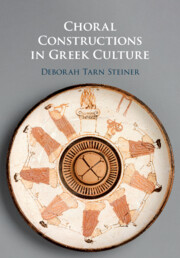 Choral Constructions in Greek Culture
Choral Constructions in Greek Culture Book contents
- Choral Constructions in Greek Culture
- Choral Constructions in Greek Culture
- Copyright page
- Dedication
- Contents
- Illustrations
- Preface and Acknowledgements
- Introduction
- 1 Choreia at the Forge: Tripod Cauldrons, Golden Maidens and the Choral Dancers on Achilles’ Shield in Iliad 18
- 2 From the Demonic to the Divine: Gorgons, Cauldrons and Choral Dance
- 3 Flying with the Birds: Avian Choreia and Bird Choruses in Art and Text
- 4 The Carnival of the Animals: Dancing in Herds
- 5 Water Music: Nymphs, Ships and Choral Aquatics
- 6 A Chorus of Columns: Pindar’s Agalmata and the Architectural Chorus
- 7 Choral Fabrications: Weaving, Cloth-Making and Choral Song and Dance
- 8 Choreo-graphy: Choreia and Alphabetic Writing
- 9 Girls in Lines: Catalogues and Choruses
- 10 Choral Envisioning: Archaic and Early Classical Choral Lyric and Post-Classical Accounts of Enargeia
- Bibliography
- Index Locorum
- Subject Index
- References
Bibliography
Published online by Cambridge University Press: 20 May 2021
- Choral Constructions in Greek Culture
- Choral Constructions in Greek Culture
- Copyright page
- Dedication
- Contents
- Illustrations
- Preface and Acknowledgements
- Introduction
- 1 Choreia at the Forge: Tripod Cauldrons, Golden Maidens and the Choral Dancers on Achilles’ Shield in Iliad 18
- 2 From the Demonic to the Divine: Gorgons, Cauldrons and Choral Dance
- 3 Flying with the Birds: Avian Choreia and Bird Choruses in Art and Text
- 4 The Carnival of the Animals: Dancing in Herds
- 5 Water Music: Nymphs, Ships and Choral Aquatics
- 6 A Chorus of Columns: Pindar’s Agalmata and the Architectural Chorus
- 7 Choral Fabrications: Weaving, Cloth-Making and Choral Song and Dance
- 8 Choreo-graphy: Choreia and Alphabetic Writing
- 9 Girls in Lines: Catalogues and Choruses
- 10 Choral Envisioning: Archaic and Early Classical Choral Lyric and Post-Classical Accounts of Enargeia
- Bibliography
- Index Locorum
- Subject Index
- References
- Type
- Chapter
- Information
- Choral Constructions in Greek CultureThe Idea of the Chorus in the Poetry, Art and Social Practices of the Archaic and Early Classical Period, pp. 702 - 727Publisher: Cambridge University PressPrint publication year: 2021


